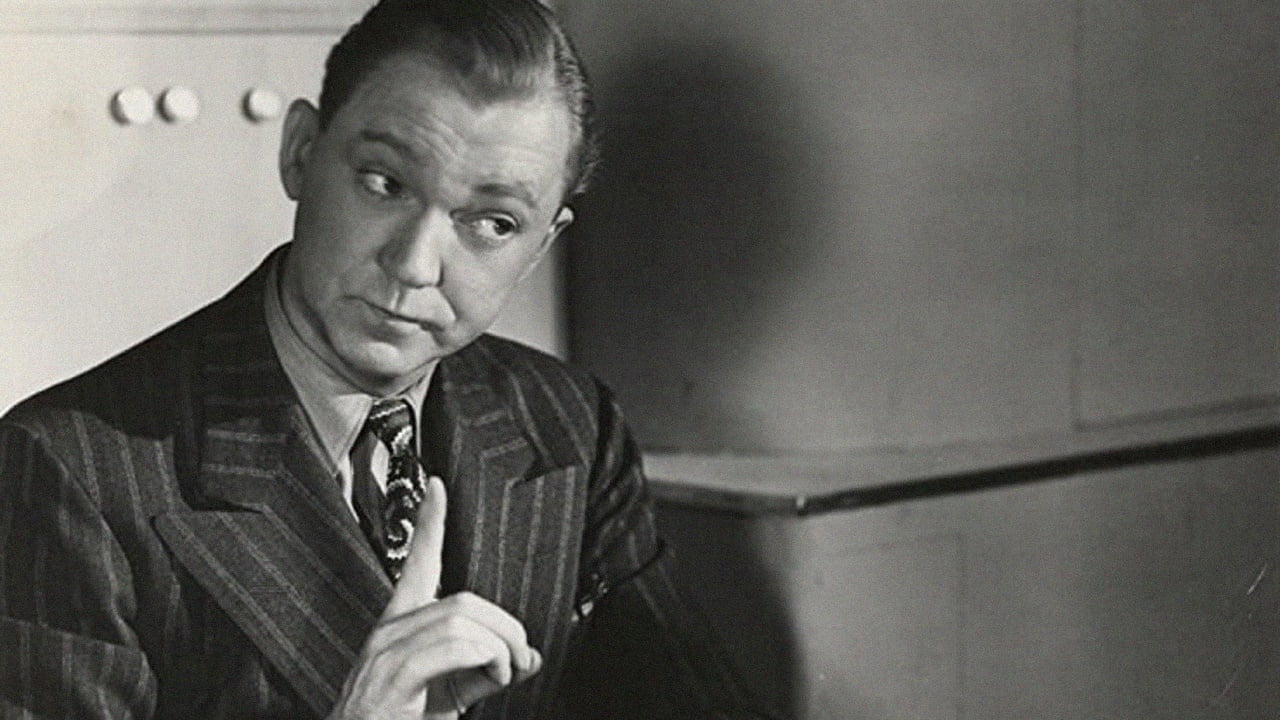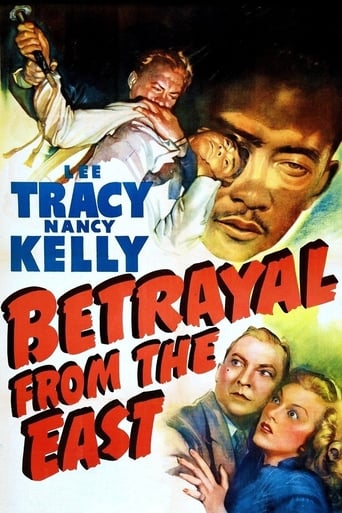

Made at the End of WWII but Set before Pearl Harbor, this B-Movie is one of those Yellow Peril Types that Actually has more Japanese Actors than Americans and They are All Up to No Good. They are Sneaky, Barbarous, and have a lot of Cash to Pay Americans if Only They would Betray Their Country.Lee Tracy, a Second Rater and Hardly Anything Approaching Handsome is Given the Lead Romantic Role and the Love Angle in this Chock Full of Jap Bashing Film is Anything but Believable. There are Some Striking Scenes of Torture and Surprising Deaths and the Plot Moves at a Rapid Pace with Hidden Surveillance and a Climactic Fight Scene that is Impressive. Overall it is Worth a Watch as a Timepiece. It is Bookended with Real Life Journalist Drew Pearson Staring at the Camera and Delivering a "This can never happen again" Warning.Note...Don't fail to miss the opening Title Card with a drawing of a Sinister Jap with Werewolf fangs.
... View MoreWhen RKO released "Betrayal from the East," World War II was into its waning days. Nevertheless, the Japanese are portrayed as vicious, omniscient antagonists with the Nazis running a close second in this tale about pr-Pearl Harbor espionage. A couple of Americans in Tokyo have gotten hold of some volatile information about high-ranking Japanese military officials in the United States, but they are killed before they can get the information to U.S. military intelligence referred to here as G-2. One of the Americansa leading newspapermandies from a mysterious fall while the other vanishes into the ocean on his voyage to San Francisco. It seems that the wily Japanese want information about the Panama Canal so that they can shut down the canal and prevent the U.S. from shipping men, munitions, and ships through this important point. That's when carnival barker Eddie (Lee Tracy of "Bombshell") finds himself lured into the story. The Japanese contact the wise-talking Eddie and he assures them that he was not only stationed in the Canal Zone during his six years in the Army but also that he knows a sergeant who can get him to the plans to the zone. The Japanese pay his expenses on the way south to the canal. Before they set out for Panama, they show him what they do to double agents. We see a gardener that the villains have captured and Eddie watches for a moment or two as they try to sweat information out of him then approach himthe gardenerwith the glowering end of a steel rod. Later, Eddie learns that an attractive clothing designer that he met on the train trip to L.A. was another agent. Although he has made a deal with the Japanese, Eddie goes to G-2 and they reveal that they have been tailing him the entire time. Despite the threat of torture and execution, our intrepid hero decides to play along with the Japanese. Unfortunately, the scenarists have written Eddie as a dim-witted idiot who finds himself in over his head and makes virtually every mistake that can be made. Meanwhile, the Japanese villains are portrayed as experts and nothing is too devious for them. "Betrayal from the East" is the kind of Hollywood propaganda that the studios churned out to the chagrin of the U.S. Office of War Information (O.W.I.) during World War II that painted the Japanese as double-crossing, back-stabbing dastards. Along the way, the clothing designer Peggy Harrison (Nancy Kelly of "Tarzan's Desert Mystery") falls in love with Eddie and stages her own death to protect from the Japanese. Actually, the Japanese placed a camera in Eddie's apartment so they knew that Harrison was a U.S. spy. When Eddie reaches the Canal Zone, he meets with an Army sergeant (Regis Toomey) who is impersonating the Eddie's fictitious friend and they arrange to pass the Japanese false, out-of-date Canal Zone defense plans. Prolific scenarist Audrey Wisberg and director William A. Berke then pull a real boner by reinserting the Harrison character back into the story in the Canal Zone (much to Eddie's surprise and consternation as a woman with impeccable credentials who is a Nazi agent's girlfriend. The Japanese suspect the Harrison character from the get-go as untrustworthy and eventually the Nazis come around to their way of thinking. Peggy blows her cover when she warns Eddie about a plot to murder him by his Japanese employers. Yes, Eddie is so incredibly cretinous that he does things that a four-year old would never do when he tries to outwit the Japanese. Now, "Betrayal from the East" not only kills off both Peggy (she dies in a sauna bath) but also the chief Japanese villain (Chinese actor Richard Loo) kills Eddie just as G-2 breaks down the door. Journalist Drew Pearson appears in a prologue where he warns Americans that this kind of treachery must never happen again. Actually, if you want to see this story done with great credibility and more dramatic impact, watch the Warner Brothers 1942 release "Across The Pacific" with Humphrey Bogart where he strings along with Japanese saboteurs who want similar information about the Canal Zone.
... View MoreA compelling WW2-era propaganda film dealing with Japanese and American espionage, where a carnival showman becomes mixed up in it all, as he decides to foil Jap plans to sabotage the Panama Canal. This takes him oversees where he was to be a patsy, but ends up a hero instead. He falls for a lovely double-agent, a-la Mata Hari, as she does for him, yet their love becomes most complicated until she perishes in a tragic twist. Two times in one film! After a long and nasty fight with a Japanese military official disguised as a shipman, he becomes a rather martyred character for the glory of the stars and stripes. A special message for audiences awaits at the end.
... View MoreWith World War II approaching, Japan's diplomatic services push a global message of peace but, behind the scenes they plot their attack on the US, using a network of spies and traitors to get information to aid their mission. In America, Japanese secret agent Kato approaches former soldier Eddie Carter to recruit him to report back the details of the Panama Canal. Eddie is down on his luck and working as an announcer in a tacky fair sideshow and he agrees to help them for a big payday. However he quickly has his doubts and finds himself in the position to do the right thing for the US and act as a double agent.With lots of talk about "Japs" and the title sequence involving a typical "yellow menace" image of a Japanese man it is no surprise that this thriller is very much a simple propaganda film. Presented by newsman Drew Pearson, we are told the story of how "friendly" Japanese in America are really spies, not to be trusted, who use their cunning and sweet talk to win over a typically good American to make him betray his country. Unsurprisingly the drama is as simple as the characters and although it works well enough on the level of an engaging piece of propaganda it doesn't have too much to make it stick in the mind; with perhaps a late scene of steam bath torture being the one exception. It goes where you expect it to and it moves forward without the pace and tension that I would have liked but, like I said, as a simple propaganda thriller it just about does enough.The cast match this approach by being solid but nothing more. Lee Tracy is a cookie-cutter all-American Joe who does "the right thing" and opens all our eyes to the fact that no Japanese people in America can be trusted. He is OK but I wonder does he regret his role given what happened to Japanese Americans around this period? Kelly is alright and Ahn and Biberman do their usual roles in American films from the time but generally they all turn in the type of solid performances that one would expect to find in this type of thing.Overall this is an OK but unmemorable thriller that is heavy with propaganda and a sense of fear-driven rabble-rousing. It more or less works as a simple b-movie but it is hard to totally get into it when looking back with hindsight and modern eyes and seeing the clear racism and very broad strokes used to present clean-cut white heroes and smarmy, untrustworthy yellow devils.
... View More